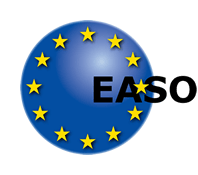European Asylum Support Office
 | |
| Agency overview | |
|---|---|
| Formed | 1 February 2011 |
| Jurisdiction | European Union |
| Headquarters | Valletta, Malta |
| Motto | Support is Our Mission |
| Agency executive |
|
| Key document | |
| Website |
easo |
The European Asylum Support Office (EASO)[1] is an agency created by European Union Regulation 439/2010 to strengthen the cooperation of EU Member States on asylum, enhance the implementation of the Common European Asylum System, and support Member States under particular pressure.[2]
History
In 2008, the European Commission proposed the creation of an asylum office such as EASO to boost cooperation between member states in managing asylum requests.[3]
Malta's EU ministers for immigration in 2010 agreed for EASO to be based in Malta, followng discussions surrounding the continuous immigration of illegal immigrants mostly from the Horn of Africa, who reach Europe after passing through Libya. On November 30 in Brussels, at the Justice and Home Affairs Council, Malta was official elected to host the organisation, winning out over candidates, Cyprus and Bulgaria.[3]
The April 2015 Mediterranean Sea migrant shipwrecks led European leaders to reconsider their border control and migrant processing policies.[4] On April 20, the European Commission proposed a 10-point plan that included EASO in the process of assisting asylum applicants and collecting information about smuggling operations.[5]
In April 2016 the European Commission proposed to transform EASO into a European Union Agency for Asylum.[6]
Current Model
The EASO regulation came into force on the 19th of June 2010 and was fully operational on the 1st of February 2011.[7]
The main aim of the EASO is to facilitate the improved protection for asylum seekers and coordination between member states.[8]
In the case of a large intake of asylum seekers within a specific country, EASO can provide temporary support. An operation plan is drawn up describing the goals of the plan, duration, geographical area and team responsibility. This program provides expertise in asylum seeker policies allowing for a smoother transition between countries.[9]
Successes
Following an unprecedented migrant influx, EASO in 2015 proposed a relocation programme that was agreed upon to support the ‘frontline’ Member States of Italy and Greece, whom were under considerable pressure.[10]
"After a proposal made by the Commission in May 2015, the Council adopted two decisions – (EU) 2015/1523 and (EU) 2015/1601 respectively – establishing a temporary and exceptional relocation mechanism for 160 000 applicants in clear need of international protection from Greece and Italy, to be implemented over two years until September 2017."[10]
Asylum Seeker Crisis
The May 2016 trend report, illustrates a 5% drop in applications for international protection since April to 99,000. However, the overall number of international protection applications in the first 6 months of 2016 has exceeded those in 2015, surpassing 500,000 as compared to 350,000 in 2015.[11] The recent immigration crisis in Europe has seen most applications coming from the war-torn states of Syria, Afghanistan, and Iraq. Syria was seen to have the most applications in May with 28,056 persons claiming protection, followed by Afghanistan with 15,648, and Iraq with 10,341.[11] However, recent trends show the slowing in momentum of applications from Syria.[11]
Furthermore, given the asylum seeker crisis within Europe, the EASO should consider the ‘pooling of reception places in times of emergency’ to encourage a EU approach to asylum seekers.[12]
Future Developments
Heijer and colleagues, have recommended that EASO should become the centralised organisation "encouraging more uniform decisions".[12] They also argue that the EASO should lead more Asylum Officer training encouraging a more humane and uniform handling of asylum seekers.[12]
Executive Directors
- Mr Robert Visser – 2011–2015;
- Mr Jose Carreira – from 2016.
See also
References
- ↑ "Welcome to the European Asylum Support Office (EASO)". EASO.
- ↑ "Common European Asylum System". European Commission.
- 1 2 "IMMIGRATION : MALTA TO HOST EU ASYLUM OFFICE". European Social Policy. 7 December 2009.
- ↑ "EU leaders call for emergency talks after 700 migrants drown off Libya". Reuters. 19 April 2015.
- ↑ "European Commission – PRESS RELEASES – Press release – Joint Foreign and Home Affairs Council: Ten point action plan on migration". europa.eu. Retrieved 21 April 2015.
- ↑ http://ec.europa.eu/dgs/home-affairs/what-we-do/policies/european-agenda-migration/proposal-implementation-package/docs/20160504/easo_proposal_en.pdf
- ↑ "EASO History | EUROPEAN ASYLUM SUPPORT OFFICE". www.easo.europa.eu. Retrieved 2016-07-20.
- ↑ "About Us | EUROPEAN ASYLUM SUPPORT OFFICE". www.easo.europa.eu. Retrieved 2016-07-20.
- ↑ "Action plan".
- 1 2 "2015 EASO annual report" (PDF).
- 1 2 3 "2016 Trend Report" (PDF).
- 1 2 3 "EASO recommendations" (PDF).
External links
- European regulation "Dublin II"
- Information Report on the European policy on asylum by Thierry Mariani